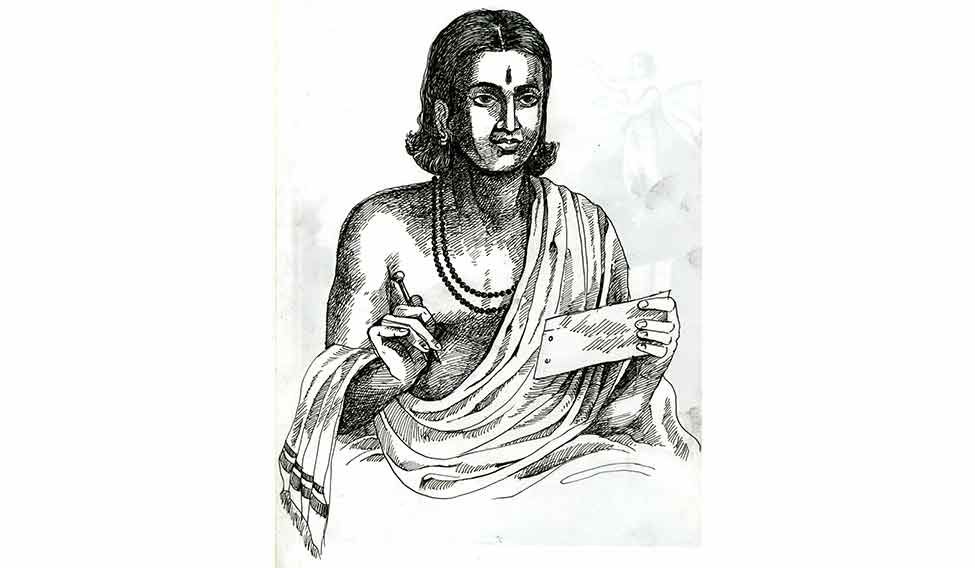COVER STORY/ KALIDASA
A poetic genius | December 27, 2015

According to one such story, Kalidasa was an illiterate blockhead who “fraudulently” got married to a princess. On realising that she was tricked, she drove him out of the house. He propitiated the goddess Kali and became Kali-dasa (servant of Kali).
Although a large number of works have been attributed to Kalidasa, scholars ascribe to him: Two epics (mahakavyas), Raghuvamsa and Kumarasambhava; two lyrics (khandakavyas), Ritusamhara and Meghaduta; three plays, Malavikagnimitram, Vikramorvasiyam and Abhijnanashakuntalam.
So, what makes Kalidasa the greatest Sanskrit poet? His work lies at the intersection of intelligence and imagination. A cursory glance at his literary works reveals his mastery over different branches of learning. Also, his works are learned but not complex. The vivid observation of the speeding deer in Abhijnanashakuntalam is described with lucidity as follows:
His neck in beauty bends
As backward looks he sends
Of my pursuing car
That threatens death afar
Fear shrinks to half the body small
See how he fears the arrow’s fall
The path he takes is chewed
With blades of grass half chewed
From jaws wide with stress
Of fevered weariness
He leaps so often and so high
He does not seem to run, but fly.
(Abhijnanashakuntalam, translated by A. W. Ryder)
He chooses suggestion over elaboration. For instance, in Abhijnanashakuntalam, Dushyanta and Shakuntala meet each other for the first time because of a bee. The bee is very suggestive of the unsteady nature of Dushyanta. This mastery of suggestiveness is unseen in prior works.
Kalidasa does not sacrifice accuracy at the altar of poetic imagination. Whether he travelled across India or based his descriptions on the information provided by traders and pilgrims, he possessed full and accurate knowledge of the geography of India. In Meghaduta, he has elaborately described the itinerary of the cloud from Ramagiri, near Nagpur, to Alaka, an imaginary place situated in the Himalayas. Kalidasa mentions mountains, rivers, forests, flora and fauna with perfect detailing. Pearl fisheries, saffron plants, cardamom creepers, sandalwood, palms and fruit plantations are described in connection with those parts of India, where they are found even today.
Just as Wordsworth is regarded as ‘the priest of Nature’, Kalidasa is a nature poet. More importantly, Kalidasa’s works reveal a deep sense of ‘trusteeship’ between humans and nature. Nature is a participant or a character in his works. Shakuntala, the daughter of the celestial nymph Menaka, was left in the custody of birds as soon as she was born. A cloud is a central character in Meghaduta. It is a messenger personified, set for a journey across central India to the Himalayas to convey the message of the lovelorn Yaksha.
Kalidasa has a deep sense of political understanding. Through Raghuvamsa, he conveys a message to kings and rulers that power accepted as responsibility thrives and prospers. However, power as a means to exert authority and arrogance faces doom very soon.
In an era when poetry was largely utilised as a medium of glorification, Kalidasa transformed it into a vehicle of communicating vivid relationships across different strata of society as well as between human and nature. The above goes to show the poetic genius of Kalidasa. No wonder his works are referred to as abhijaata (classic) and continue to mesmerise audiences even today.
Madhavi Narsalay is assistant professor and head, department of Sanskrit, University of Mumbai.
Bharata Muni
Play maker
Bharata Muni is said to be the composer/compiler of the Natya Shastra, a treatise on dramaturgy and music. After creating the Natyaveda, the fifth Veda, Lord Brahma asked Bharata Muni to put it into actual performance. Having learned the intricacies of this treatise, Bharata Muni taught it to his disciples and thus popularised theatre in India.
Natya Shastra, with 36 chapters, is the oldest and most acclaimed treatise on performing arts in ancient India. In this encyclopaedic work, Bharata Muni discusses facets of dramaturgy such as the origin of drama, construction of theatre, theory of rasa, theatrical skills, dialogues, scriptwriting, production, stage direction, music and casting of actors.
Bharata Muni not only speaks about techniques of theatre, but also tries to answer the core question about the entertainment factor in any performing art. He felt that rasa (loosely translated as sentiment) is the key factor behind entertainment. In promoting theatre, Bharata Muni’s intention was to create a strong ethical foundation for future generations based on moral uprightness and cultural sensitivity. He extended the scope of theatre to such an extent that nothing in this world remains untouched by it
http://www.theweek.in/theweek/cover/kalidasa-a-poetic-genius.html

